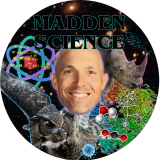NOAA Teacher at Sea
David Madden
Preparing to Board NOAA Ship Pisces
July 15 – 29, 2019
Mission: South East Fisheries Independent Survey
Geographic Area of Cruise: Atlantic Ocean, SE US continental shelf ranging from Cape Hatteras, NC (35º30’ N, 75º19’W) to St. Lucie Inlet, FL (27º00’N, 75º59’W)
Date: July 11, 2019

Introductory Post
Personal Log:
Hello friends,
My name is David Madden. I am a high school science teacher at Maclay School in Tallahassee, FL, and I’m getting ready to go on my NOAA Teacher at Sea cruise! I recently completed my 21st year teaching – it’s been a super fun journey. I am as excited heading into year 22 as I was in years 1-5. I’ve been in love with nature since I can remember.

Over the course of my career I’ve taught: AP Biology, regular Biology, Physics, Integrated Science (bio, chem, phys combined), and Marine Biology. This upcoming year I will also be teaching AP Environmental Science. I’ve loved every minute of my job – teaching and learning with students, challenging myself and being challenged by my friends and colleagues, and exploring new adventures – like NOAA Teacher at Sea. Along the way I’ve also been a coach, helping kids learn the value of sports, including: volleyball, basketball, tennis, and track.
Over the last few years I’ve started making educational videos for my students – as a way for them to further develop their love of science and grow their scientific literacy: Madden Science on YouTube and www.maddenscience.com.

Starting on July 15th, 2019, I will be aboard NOAA Ship Pisces as part of the Southeast Fishery-Independent Survey (SEFIS). The mission of the cruise will be to conduct “applied fishery-independent sampling with chevron fish traps and attached underwater video cameras, and catch rates and biological data from SEFIS are critical for various stock assessments for economically important reef fishes along the southeast US Atlantic coast.” It’s an amazing opportunity for me to participate in important scientific research. I have the opportunity to work alongside and learn from some of the best scientists in the world.

NOAA Ship Pisces. Photo by National Oceanic and Atmospheric Administration.
There are so many things about NOAA Teacher at Sea that I’m looking forward to. Here’s a few:
- Spending time out on the ocean, experiencing the energy and power of the wild sea.
- Working with and learning from some of the world’s leading oceanic and atmospheric scientists.
- Learning about fish and marine biodiversity in the Atlantic.
- Asking tons of questions and hopefully learning more about the ocean and its central importance in our changing world.
- Sharing my experience with you; my family, friends, students, and the public. I’ll share this adventure via this blog and also via videos I hope to create while on NOAA Ship Pisces. My goal is for these blog posts and videos to serve as a real-time record of the cruise, to be helpful and interesting right now, and also to help serve as resources for my classes and other classrooms around the world.
Neato Fact:
NOAA Ship Pisces is 209 feet (64 meters) long. To give you an idea, that’s basically 70% of a football field. That’s longer than two blue whales (~90 feet), the largest and longest animal to ever live! Usain Bolt can run that far in 6.13 seconds (assuming 9.58 s for 100 m). A starfish, traveling at 60 feet/hour, would take about 3.5 hours to travel the length of Pisces.

I’d love it if you could join in with me on this adventure – please comment and ask questions. I’ll do my best to respond in a helpful and interesting way!

